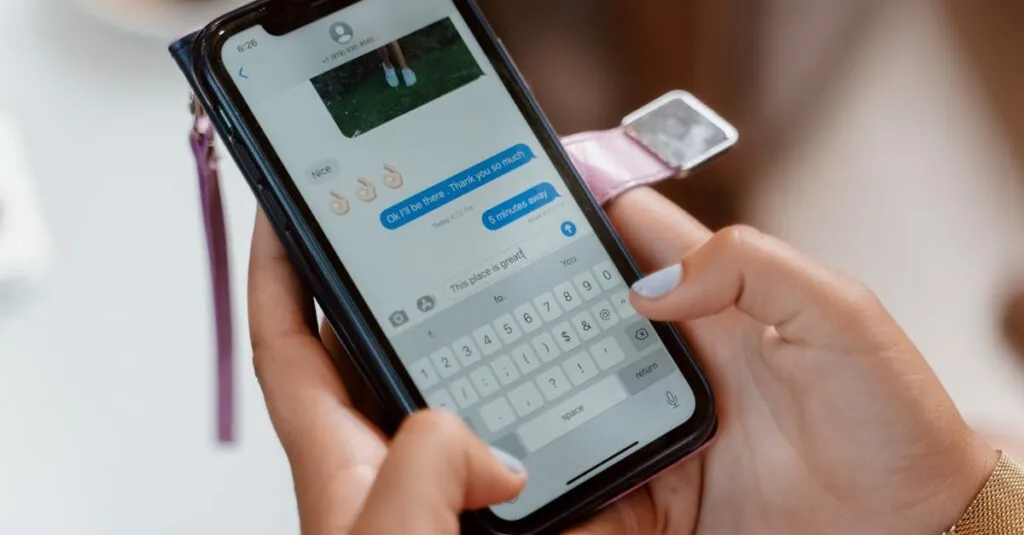Table of Contents
ToggleIn a world where buffering videos feels like waiting for a snail to cross the street, connecting to 5G on an iPhone is like finding a golden ticket to the fast lane. This next-gen network promises lightning-fast speeds and seamless streaming, making your favorite cat videos even more enjoyable. But fear not, tech novices! Getting connected isn’t rocket science—it’s more like riding a bike, with a few wobbles along the way.
Understanding 5G Technology
5G technology represents the fifth generation of mobile networks, offering enhanced connectivity for users. With upload speeds reaching up to 1 Gbps and download speeds potentially exceeding 10 Gbps, the differences from previous generations are substantial. Lower latency also plays a significant role, enabling near-instantaneous communication between devices.
Key components of 5G include enhanced mobile broadband, ultra-reliable low latency communication, and massive machine-type communications. Enhanced mobile broadband provides users with faster data speeds, benefiting activities like streaming, gaming, and virtual reality. Ultra-reliable low latency communication ensures timely data transmission, crucial for applications in healthcare and autonomous vehicles. Massive machine-type communications support numerous connected devices simultaneously.
5G encompasses three frequency bands: low-band, mid-band, and high-band, each offering distinct advantages. Low-band signals cover large areas but provide slower speeds. Mid-band signals offer a balance between speed and coverage. High-band signals, known as mmWave, deliver the fastest speeds but have limited range and penetration through obstacles.
Network deployment for 5G continues to evolve, requiring infrastructure investments. Carriers expand coverage and develop technology to maximize the benefits of 5G. Smartphone manufacturers adapt their devices to support 5G, ensuring user accessibility to cutting-edge technology.
Understanding 5G technology empowers users to leverage its capabilities effectively. Knowledge of frequency bands, speed variations, and connectivity options enriches the experience. With the right device and network support, users can fully enjoy the advantages of 5G.
Prerequisites for Connecting to 5G
Connecting to 5G requires essential components before users can enjoy the benefits of this advanced network. Users must ensure they meet compatibility and carrier support needs.
Compatible iPhone Models
Compatible iPhone models include the iPhone 12, 13, 14 series, and later releases. Each of these models supports 5G connectivity, enabling users to access enhanced speeds. Users who have older models, such as the iPhone 11 or earlier, won’t connect to 5G networks. Apple’s commitment to 5G technology ensures that newer models fully leverage its capabilities for superior performance.
Carrier Support
Carrier support plays a crucial role in 5G connectivity. Major carriers, such as Verizon, AT&T, and T-Mobile, offer 5G services across various regions. Users should verify if their specific area has 5G coverage from their carrier. Additionally, some plans might have limitations on 5G access, so confirming plan details ensures users can enjoy uninterrupted connections. Choosing a compatible plan with 5G support maximizes the benefits of having a 5G-capable iPhone.
Step-by-Step Guide on How to Connect to 5G on iPhone
Connecting to 5G on an iPhone involves straightforward steps. Follow the instructions below to enable 5G and select the appropriate plan.
Enabling 5G in Settings
Accessing the Settings app is the first step. Tap on “Cellular” to begin. Next, select “Cellular Data Options” and then choose “Voice & Data.” Here, users can toggle the 5G option to enable it. Options available include “5G On,” “5G Auto,” and “LTE.” Selecting “5G On” allows maximum speed usage, while “5G Auto” optimizes performance based on coverage and device needs.
Selecting a 5G Plan from Your Carrier
Choosing a 5G plan is essential for accessing 5G services. Contacting your carrier, such as Verizon, AT&T, or T-Mobile, provides information on available 5G plans. Each carrier offers different pricing, coverage areas, and features. Confirming 5G benefits and limitations in your area ensures you maximize the connection potential. Meeting the plan requirements enables seamless streaming and browsing experiences on 5G.
Troubleshooting Common Connectivity Issues
Experiencing connectivity issues while trying to access 5G on an iPhone can be frustrating. Users can resolve these problems through specific steps.
Resetting Network Settings
Resetting network settings often resolves persistent connectivity issues. To do this, navigate to Settings, then General, and select Reset. After tapping Reset Network Settings, confirm the action. This process removes saved Wi-Fi passwords and cellular settings, so users should re-enter any necessary information afterward. Expect faster reconnections once the settings refresh.
Contacting Your Carrier for Assistance
When troubleshooting does not yield success, contacting the carrier can provide expert help. Major providers like Verizon, AT&T, and T-Mobile often have dedicated customer support for 5G issues. Users should prepare their account details and device information for a smoother experience. Carrier representatives can offer specific guidance tailored to your plan and area. Furthermore, they can verify local coverage status, ensuring users can access available services.
Connecting to 5G on an iPhone opens up a world of enhanced speed and connectivity. With the right device and carrier support users can enjoy seamless streaming and rapid downloads. Following the simple steps outlined ensures a smooth transition to this advanced technology.
By understanding the different frequency bands and how to troubleshoot common issues users can maximize their 5G experience. As 5G networks continue to expand staying informed about coverage and plan options will help users fully leverage the benefits of this cutting-edge mobile network. Embracing 5G technology can significantly enrich the overall smartphone experience.







